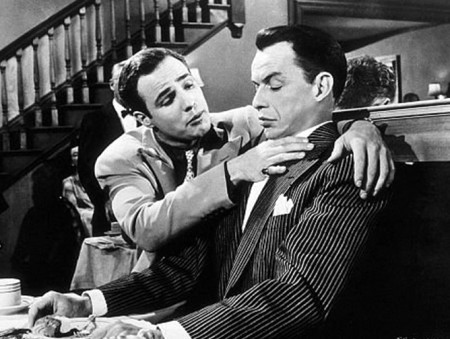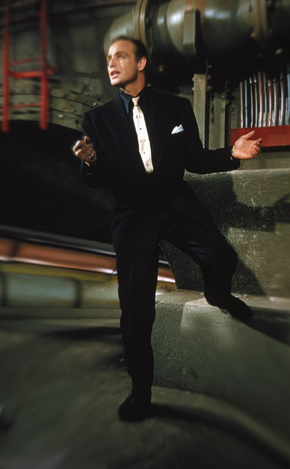
 |
|
|
|
MGM's 2006 DVD of Guys and Dolls had some transfer issues that appear to be cleared up in this Blu-ray presentation. The Goldwyn Library moved from MGM to Warners at the beginning of this year, and hopefully the Shield will be more aggressive than was the Lion with classics like The Best Years of Our Lives. Guys and Dolls is still an arresting musical. For those with some knowledge of the original stage version, it has always been an object of opinionated discussion. 
Sam Goldwyn's 1955 production shows what can happen when Broadway collides with Hollywood. The top-name casting promises a lively and memorable show, but Abe Burrows and Frank Loesser's musical underwent some awkward changes on the way to the screen. Something's seriously out of kilter when non-singer Marlon Brando plays the romantic lead with the big love ballads, and the supremely talented crooner Frank Sinatra gets the "character" novelty numbers. Bent out of shape to accommodate its stars, the film sags in the middle. The most flavorful scenes are still those performed by New York stage originators Vivian Blaine and Stubby Kaye. Guys and Dolls remains a fifties' musical favorite with both star power and a unique look. Unlike some of the literal Rogers and Hammerstein adaptations, it uses no real exteriors. But its oddly stylized sets do not resemble those in MGM's musicals, either. Despite the effects of the counterproductive casting choices, superb orchestrations of the Frank Loesser score guarantee that the film will work anyway. The Damon Runyon Broadway fantasy with its loudly dressed sidewalk hustlers speaking stylized lingo has been a hit for sixty years. A spirited prologue immediately drops us into a New York fantasy world. Superstitious gambling promoter Nathan Detroit (Frank Sinatra) is desperate for cash to float his latest floating crap game. He makes a crazy bet with high-rolling lady killer Sky Masterson (Marlon Brando) that Masterson cannot seduce prim Salvation Army Sergeant Sarah Brown (Jean Simmons). Nathan's cohorts Benny Southstreet (Johnny Silver) and Nicely Nicely Johnson (Stubby Kaye) run interference with tough Lieutenant Brannigan (Robert Keith) and help to placate Nathan's longtime fiancée Miss Adelaide (Vivian Blaine), a burlesque entertainer psychosomatically ill over having no wedding ring. The pressure on Nathan mounts: out of town gangster Big Jule (B.S. Pully) expects big winnings in a big game, and the slippery Sky is making good time with the stubbornly virtuous Sergeant Brown, on an overnight trip to Havana! It made perfect box office sense for Sam Goldwyn to put Marlon Brando into Guys and Dolls, as the actor would deliver an enormous audience curious to see him sing in a big-scale musical. Marlon is fine from an acting point of view. He's magnetic, sexy and plays excellently opposite the exciting (and even sexier) Jean Simmons. Brando cheats his way through his songs, emoting to distract us from his dead-ear flat rendition of "I'll Know." It's little wonder that when he later played 'musical' types, as with his supposedly phenomenal folk singer in The Fugitive Kind, Brando merely mumbled his way through bits of music. This Sky Masterson is earnest and endearing when he sings to Sergeant Sarah Brown, but he sure can't carry a tune. We wonder who in their right mind would allow Brando to choke his way through tunes like "Luck Be a Lady"? Frank could have blown the roof off with that song. Sinatra's Nathan Detroit character is supposed to be a New York Jewish worrywart, and in the play he was given just one kooky comedy song, "Sue Me." Sinatra refuses to play Nathan as neurotic or Jewish. He's given the two other songs that Nathan Detroit could possibly sing even though their optimism doesn't jibe with his character, "The Oldest Established" and "Guys and Dolls". With Sinatra belting them out, the original conception of Nathan Detroit changes from a nervous loser to ... a rather hazily defined secondary romantic lead. 
In Guys and Dolls Sinatra looks uncomfortable moping about while other actors are screen center. He's more or less out-classed by Brando and out-"cute-ed" by Vivian Blaine; he loiters like a spear-carrier in the background of the dance at the crap game. It needs to be stressed that when Sinatra took on this role he was not yet a formidable Hollywood power broker. After another success or two he'd always be the biggest force in his shows and would mostly appear in roles consistent with his "Ring-a-ding" persona. Sinatra did have the clout to demand a new song of his own, the classy "Adelaide." Sung in his confident cabaret style, it's a beautiful tune that doesn't really belong in the mouth of the desperate, sweaty Nathan Detroit. As for Brando, several songs for Sky Masterson are dropped and appear only in instrumental underscore. Especially missed is Frank Loesser's Broadway-defining personal favorite "My Time of Day." Jean Simmons danced and sang as a kid in English movies, and proves to be excellent musical material. Simmons has the grit to embody the predictably repressed Sarah Brown, so the emergence of her romantic side comes as a revelation. When the Salvation Army leader discovers passion in Havana, Simmons is almost too hot for the movie. Vivian Blaine had been a non-starter in Hollywood ten years before when she was the lead in a lesser Laurel & Hardy picture. But she played Miss Adelaide to such satisfaction on stage that it became her defining role. Standard Hollywood procedure was to jettison stage actors for Hollywood stars, as with Gloria Grahame and Ado Annie in Oklahoma! Goldwyn wisely retained Blaine for his film version. If she sometimes seems a bit too much for the movie, it's yet another side effect of Sinatra's casting. Nathan Detroit was originally a clownish sad sack of a gambling addict, not a philosophical smoothie. Adelaide's New York accent and hypochondriac whining are make her a perfect match for Nathan, but in the film she seems something of an endearing millstone around his neck ... ... Until she gets on stage, that is. Blaine is terrific in her songs at the burlesque nightclub. Goldwyn apparently just didn't "get" the barnyard song "Bushel and a Peck" -- a monster radio hit -- and dropped it from the show (!!). In its place Loesser cooked up "Pet Me Poppa", a teasing kitty-kat themed number. It emphasizes a chorus of impossibly leggy dancers that could be handily promoted as a new group of "Goldwyn Girls." The supporting personalities are delightful. Goldwyn retained Nathan Detroit's sidewalk chorus of retainers, Stubby Kaye's Nicely Nicely Johnson and Johnny Silver's Benny Southstreet. The always-personable Kaye (Li'l Abner, Cat Ballou) has arguably the film's most arresting number all to himself, the fast-patter hymn "Sit Down You're Rockin' the Boat." Sheldon Leonard gets the lion's share of the best Damon Runyon dialogue, reminding us that these are supposed to be lowlifes when he turns in his own father to finance his wagers. B.S. Pulley is an effective lug as the original Big Jule,. We're told that Pulley was a nightclub comic who did profane intros for strippers, like DeNiro's Jake LaMotta in Raging Bull. Joseph L. Mankeiwicz adapted and directed, and fairly well, although some passages seem slow after all the adjustments. The memorable dance staging is all by Michael Kidd, fresh from Seven Brides for Seven Brothers. Kidd originated the choreography on stage. When asked about his inventive Latin dances for the Havana sequence, Kidd immediately admitted that none of it was researched or authentic -- he just made it all up! 
Veda Ann Borg's Laverne is a character added by Mankiewicz to provide an extra voice to scoff at Nathan Detroit. A welcome supporting face is Mary Alan Hokanson as the second-string Salvation Army member, Agatha. Fantastic film fans will remember her immediately as the teary-eyed Mrs. Lodge from the previous year's Them! Warners' Blu-ray of Guys and Dolls is getting good reviews for picture quality. I remember hearing that at least one MGM HD transfer had issues, that I believed were corrected in a later pass. I don't know if this release uses MGM's master or is a new Warners transfer. The slightly wider picture reflects the original 2.55:1 CinemaScope aspect ratio. Sharpness is tops and the colors are bright overall. The stylized graphic designs throughout the film are entertaining in themselves -- a lot of time is spent with people on busy sidewalks, in front of colorful cafes and barbershops. The 5.1 Master Audio track reprograms the original stereo into a pleasing configuration. Any weakness in the 1955 recording is more than compensated by the robust orchestrations. The extras are all repeats from the MGM special edition. A two part making of docu starts with the play and has interview input from Sam Goldwyn Jr., Tom Mankiewicz, Michael Kidd, Goldwyn author and authority A. Scott Berg and Frank Loesser's widow, son and daughter. It also makes use of a great number of behind-the-scenes photos from the Goldwyn collection. The end credit sequences have been deleted, leaving awkward fade-outs. I sometimes believe that home video executives would rather take poison than allow a mention of another studio's work, even though contractual agreements for credit should still be in force with these featurettes. 1 A grouping of individual 'stories' have been edited directly from the interview tapes, such as Michael Kidd talking about teaching, or trying to teach, Marlon Brando to dance. A theatrical trailer is present as well. The packaging contains one of Warners' souvenir booklets, with a great many color photographs and more relevant production and publicity information.
On a scale of Excellent, Good, Fair, and Poor,
Guys and Dolls Blu-ray rates:
Footnote:
1. Gee, Glenn seems disproportionately concerned about the excision of a couple of lousy credit sequences. Why? Because I spent a number of weeks in 2006 editing these shows. Along with everybody else, my work has been rendered anonymous.
Reviews on the Savant main site have additional credits information and are often updated and annotated with reader input and graphics. Also, don't forget the 2011 Savant Wish List. T'was Ever Thus.
Review Staff | About DVD Talk | Newsletter Subscribe | Join DVD Talk Forum |
| ||||||||||||||||||